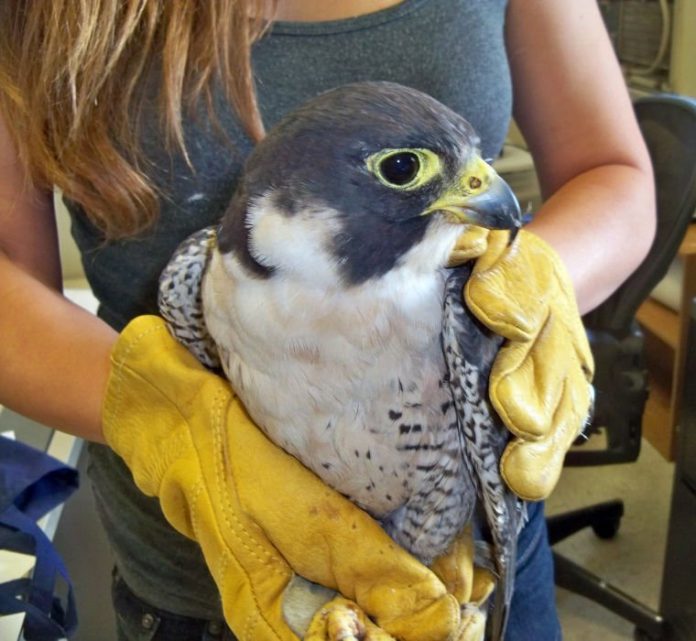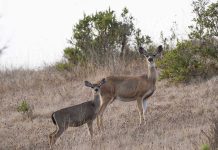
Morgan Hill is becoming THE summer destination for some really adventuresome wild animals. Just last month, I wrote about the yellow-bellied marmot who hitched a ride on a car from the Eastern Sierra to Morgan Hill. This month’s adventure story is about a backpacking peregrine falcon who found our south Bay Area location a perfect spot for a little R & R (rest and recuperation).
Early in July, a local family noticed an injured falcon in the middle of a field. They rescued it and brought it to the Santa Clara County Animal Control and Care, which contacted the Wildlife Education and Rehabilitation Center. Because the falcon was sporting a leather anklet, the agency also contacted Kenny Elvin, an expert falconer.
Elvin explained that the “backpack” is actually a radio transmitter attached to the falcon’s back, and helps track a wandering or lost bird. In this case, it’s definitely fitting that the raptor’s species name is falco peregrinus, meaning wandering falcon.
Elvin put out word on the falconer network and learned that Karl Kerster, a falconer for more than 30 years, owned a male peregrine (called a “tercel”) named Beethoven that had flown off during a demonstration at San Francisco in April. Unfortunately, the transmitter signal was scrambled and Kerster was unable to locate his falcon. (By coincidence, the composer Beethoven wrote an apt folk song – bet you didn’t know he wrote more than just concertos – called “A wand’ring gypsy, Sirs, am I.”)
The peregrine falcon is the fastest bird in the world, and when swooping down after avian-prey, can reach speeds of up to 200 miles per hour. Peregrines are well-known for their endurance and American sub-species that migrate (some are year-round residents) will fly hundreds of miles from their Alaskan and far-north Canadian summer breeding areas to their winter range in South America.
Fortunately, this particular peregrine didn’t need to make such a long-distance trek, flying 70 miles from San Francisco to Morgan Hill. The handsome 17-inch-long bird with distinctive black “sideburns” may have taken a meandering route as he apparently survived 83 days in the wild, though there are suspicions that he might have been captured and kept in a cage illegally for some period of time. During his time on the lam, the falcon had not only injured its right leg, causing him to have trouble standing, but had somehow lost all of his tail feathers. Still, he was in remarkably good condition considering his travel travails, just a little hungry – when offered some fresh fowl, he immediately pounced on it and began eating.
WERC verified the falconer’s permits in order to “dot the i’s and cross the t’s” for U.S. Fish and Wildlife Service records. Then, just as lost dogs and cats at the animal shelter are scanned for an implanted microchip in order to return them to their family, the falcon was scanned with a sensor wand which verified that he was, beyond any doubt, Beethoven. Elvin gladly transported him back to his owner in Sacramento, who was elated to have Beethoven home and reunited with his brother, Bach.
Falconry is an ancient technique using trained falcons and other raptors to hunt for wild prey, either for food or for sport. It was popular throughout Europe, the Middle East, Asia and by the Aztecs in Central America. Shakespeare and Henry VIII were avid falconers, and Shakespeare included many references to the sport in his plays.
Falconry is also a “working bird” enterprise. During wartimes, both modern and medieval armies used homing pigeons to send messages, and falcons were trained to intercept the enemy’s birds. The U.S. Army even had a pigeon corps and a falcon corps during WWII.
Today, the raptors are used for bird abatement (pest-bird control). In an environmentally sound method, modern companies “hire out” falcons and hawks to scare off nuisance birds, such as gulls, pigeons, sparrows, starlings and crows, which may damage crops, create unsanitary and health hazards at landfills and golf courses, and compromise the safe takeoffs of planes on airfields. It’s a technique that works well because nuisance birds don’t become acclimatized to the raptors – their natural enemies – as they do to other methods of deterrents such as scarecrows or shooting off loud propane cannons.
The Wildlife Education and Rehabilitation Center rehabilitates native wildlife. It is supported solely by donations from businesses and the public. To contact WERC, call (408) 779-9372 or visit www.werc-ca.org.











